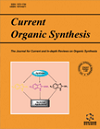- Home
- A-Z Publications
- Current Organic Synthesis
- Previous Issues
- Volume 17, Issue 4, 2020
Current Organic Synthesis - Volume 17, Issue 4, 2020
Volume 17, Issue 4, 2020
-
-
Advances in Synthesis and Medicinal Applications of Compounds Derived from Phthalimide
More LessAuthors: Marcel L. Almeida, Maria C.V.A. Oliveira, Ivan R. Pitta and Marina G.R. PittaPhthalimide derivatives have been presenting several promising biological activities in the literature, such as anti-inflammatory, analgesic, antitumor, antimicrobial and anticonvulsant. The most well-known and studied phthalimide derivative (isoindoline-1,3-dione) is thalidomide: this compound initially presented important sedative effects, but it is now known that thalidomide has effectiveness against a wide variety of Read More
-
-
-
Recent Advances of Sulfonylation Reactions in Water
More LessAuthors: Li Wu, Lifen Peng, Zhifang Hu, Yinchun Jiao and Zilong TangBackground: The sulfonyl groups are general structural moieties present in agrochemicals, pharmaceuticals, and natural products. Recently, many efforts have been focused on developing efficient procedures for preparation of organic sulfones. Materials and Methods: Water, a proton source, is considered one of the most ideal and promising solvents in organic synthesis for its easy availability, low cost, nontoxic and nonflammab Read More
-
-
-
Efficient Methods for the Synthesis of Novel Arylazothiazoles Based on Acetylferrocene or Adamantane
More LessAuthors: Abdelwahed R. Sayed, Mohamed S.M. Ahmed and Sobhi M. GomhaBackground: Hydrazonoyl halides are convenient for the synthesis of arylazothiazoles. Materials and Methods: A series of novel arylazothiazoles were efficiently synthesized from the reaction of hydrazonoyl chlorides with 2-(adamantan-2-ylidene)hydrazinecarbothioamide or 2-(ferrocenyl-1-ylidene)hydrazinecarbo-- thioamide in dioxane used as an aprotic solvent because of its lower toxicity and higher boiling point (101 °C) a Read More
-
-
-
Cellulose-Supported Sulfonated Magnetic Nanoparticles: Utilized for One-pot Synthesis of α-Iminonitrile Derivatives
More LessAuthors: Jamal Rahimi, Reza Taheri-Ledari and Ali MalekiIntroduction: An instrumental strategy for α-iminonitrile derivatives preparation by Fe3O4@cellulose-OSO3H (MCSA) as an eco-friendly nanocatalyst and oxidative agent in aerobic condition, is presented. Materials and Methods: Through this method, a one-pot three-component condensation reaction of various aldehydes, primary amines and trimethylsilylcyanide (TMSCN) were applied to synthesize the desired products. It was Read More
-
-
-
Electrophilic Aromatic Synthesis of Radioiodinated Aripiprazole: Experimental and DFT Investigations
More LessAuthors: Moustapha E. Moustapha, Mohammed H. Geesi, Zeinab R. Farag and El Hassane AnouarBackground: Aripiprazole is a quinolinone derivative. It shows a high affinity for neurotransmitters dopamine and serotonin receptors, which can overcome the blood-brain barrier (BBB) to reach the central nervous system (CNS) to exert therapeutic effects. Its radioiodination may lead to high radiochemical yield and improved its affinity. Aripiprazole radioiodination is an aromatic electrophilic substitution. Objective: Herein, we i Read More
-
-
-
NiFe2O4@SiO2 @amino Glucose Magnetic Nanoparticle under Solvent-free Condition: A New, mild, Simple and Effective Avenue for the Synthesis of Quinazolinone, Imidazo[1,2-a]Pyrimidinone and Novel Derivatives of Amides
More LessBackground: Imidazo[1,2-a]pyrimidinone, quinazolinone and amide derivatives have attracted a lot of interest because of their broad scope of biological and pharmacological activities. There are a lot of methods reported in the literature for their synthesis. Therefore, we became interested in developing a convenient synthetic method for the preparation of imidazoquinazolinone and amide derivatives. Objective: NiFe2O4@Si Read More
-
-
-
An Operationally Simple and Efficient Synthesis of 7-Benzylidene-substitutedphenyl-3,3a,4,5,6,7-hexahydro-2H-indazole by Grinding Method
More LessAuthors: Santosh Raut, Bharat Dhotre, Atul Tidke and Mohammad A. PathanBackground: An eco-friendly, operationally simple and efficient reaction is shown between various 2,6-bis-(substituted-benzylidene)-cyclohexanones and differently substituted hydrazine in the presence of acetic acid. Methods: The reaction between various 2,6-bis-(substituted-benzylidene)-cyclohexanones and differently substituted hydrazine in the presence of acetic acid afforded 7-Benzylidene-substituted-phenyl-3,3a,4,5, Read More
-
Volumes & issues
-
Volume 22 (2025)
-
Volume 21 (2024)
-
Volume 20 (2023)
-
Volume 19 (2022)
-
Volume 18 (2021)
-
Volume 17 (2020)
-
Volume 16 (2019)
-
Volume 15 (2018)
-
Volume 14 (2017)
-
Volume 13 (2016)
-
Volume 12 (2015)
-
Volume 11 (2014)
-
Volume 10 (2013)
-
Volume 9 (2012)
-
Volume 8 (2011)
-
Volume 7 (2010)
-
Volume 6 (2009)
-
Volume 5 (2008)
-
Volume 4 (2007)
-
Volume 3 (2006)
-
Volume 2 (2005)
-
Volume 1 (2004)
Most Read This Month
Article
content/journals/cos
Journal
10
5
false
en


